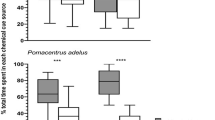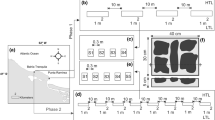Abstract
During the summer of 1995, we investigated the response of mud crab megalopae (Panopeus herbstii Milne-Edwards) to cues associated with adult habitat. Natural rock/shell substratum and the rock-associated seaweed, Fucus vesiculosus L., both induced metamorphosis of competent megalopae; natural sand substratum did not induce metamorphosis. Structural mimics of preferred substrata induced metamorphosis only when covered with natural biofilm. Clean mimics did not induce metamorphosis. Water-soluble exudates from preferred substrata showed weak induction of metamorphosis. Exudates from adult P. herbstii elicited a similar weak response. Exudates from another species of crab and from two fish predators did not induce metamorphosis. We conclude that water-soluble cues associated with major components of preferred adult habitat induce the metamorphic molt of P. herbstii megalopae. The three-dimensional structure of the substratum is not important in induction of metamorphosis, but the biofilm associated with preferred substratum plays a critical role. It is not clear whether the biofilm produces the water-soluble cue or simply provides a tactile stimulus that works in conjunction with the soluble cue.
Similar content being viewed by others
References
Abbe GR, Breitburg DL (1992) The influence of oyster toadfish (Opsanus tau) and crabs (Callinectes sapidus and Xanthidae) on survival of oyster (Crassostrea virginica) spat in Chesapeake Bay: does spat protection always work? Aquaculture, Amsterdam 107: 21–31
Benfield MC, Aldrich DV (1992) Attraction of postlarval Penaeus aztecus Ives and P. setiferus (L.) (Crustacea: Decapoda: Penaeidae) to estuarine water in a laminar flow choice chamber. J exp mar Biol Ecol 156: 39–52
Botero L, Atema J (1982) Behavior and substrate selection during larval settling in the lobster Homarus americanus. J Crustacean Biol 2(1): 59–69
Boudreau B, Bourget E, Simard Y (1993) Behavioral responses of competent lobster postlarvae to odor plumes. Mar Biol 117: 63–69
Butman CA (1987) Larval metamorphosis of soft sediment invertebrates: the spatial scales of pattern explained by active habitat selection and the emerging role of hydrodynamical processes. Oceanogr mar Biol A Rev 25: 113–165
Costlow JD, Bookhout CG (1959) The larval development of Callinectes sapidus R. reared in the laboratory. Biol Bull mar biol Lab, Woods Hole 116: 373–396
Costlow JD, Bookhout CG (1961) The larval stages of Panopeus herbstii Milne-Edwards reared in the laboratory. J Elisha Mitchell scient Soc 77(1): 33–42
Costlow JD, Bookhout CG, Monroe R (1962) Salinity—temperature effects on the larval development of the crab Panopeus herbstii Milne-Edwards reared in the laboratory, Physiol Zool 35: 79–93
Dame RT, Pattern BC (1981) Analysis of energy flows in an intertidal oyster reef. Mar Ecol Prog Ser 5: 115–124
Day EA, Lawton P (1988) Mud crab (Crustacea: Brachyura: Xanthidae) substrate preference and activity. J Shellfish Res 7(3): 421–426
Dittel AI, Epifanio CE (1982) Seasonal abundance and vertical distribution of crab larvae in Delaware Bay. Estuaries 5: 197–202
Dittel A, Epifanio CE, Natunewicz C (1996) Predation on mud crab megalopae, Panopeus herbstii H. Milne Edwards: effect of habitat complexity, predator species and postlarval densities. J exp mar Biol Ecol (in press)
Duffy JT, Epifanio CE (1994) Effects of larval density on the growth and survival of weakfish Cynoscion regalis in large-volume enclosures. Mar Ecol Prog Ser 104: 227–233
Epifanio CE (1988) Transport of crab larvae between estuaries and the continental shelf. Lecture Notes cstl estuar Stud 22: 291–305
Epifanio CE, Cope JC, Rowe PM, Jenkins F (1991) Comparison of rates of development of Atlantic mud crab larvae in the laboratory and in field-deployed enclosures. J Crustacean Biol 11: 234–240
Epifanio CE, Lobanoff ML, Connaughton VP, Welch J (1994) Growth and development of mud crab larvae in field-deployed enclosures and in the laboratory. J exp mar Biol Ecol 180: 165–174
Forward RB Jr, DeVries MC, Rittschof D, Frankel DAZ, Bischof JP, Fisher CM, Welch JM (1996) Effects of environmental cues on metamorphosis of the blue crab Callinectes sapidus. Mar Ecol Prog Ser 131: 165–177
Forward RB Jr, Frankel DAZ, Rittschof D (1994) Molting of megalopae from the blue crab Callinectes sapidus: effects of offshore and estuarine cues. Mar Ecol Prog Ser 113: 55–59
Herrnkind WF, Butler MJ (1986) Factors regulating postlarval metamorphosis and juvenile microhabitat use by spiny lobsters Panulirus argus. Mar Ecol Prog Ser 34: 23–30
Jones MB, Epifanio CE (1995) Metamorphosis of brachyuran megalopae in Delaware Bay: an analysis of time series data. Mar Ecol Prog Ser 125: 67–76
Johns PM, Mann KH (1987) An experimental investigation of juvenile lobster habitat preference and mortality among habitats of varying structural complexity. J exp mar Biol Ecol 109: 275–285
Lin J (1990) Mud crab predation on ribbed mussels in salt marshes. Mar Biol 107: 103–109
McDermott JJ (1960) The predation of oysters and barnacles by crabs of the family Xanthidae. Proc Penn Acad Sci 34: 199–211
McDermott JJ, Flower FB (1952) Preliminary studies of the common mud crabs on oyster beds of Delaware Bay. Conv Adr natn Shellfish Ass 1952: 47–50
McDonald J (1977) The comparative intertidal ecology and niche relations of the synpatric mud crabs, Panopeus herbstii (Milne-Edwards) and Eurypanopeus depressus (Smith), at North Inlet, South Carolina, USA (Decapoda: Brachyura: Xanthidae). Ph.D. Dissertation, University of South Carolina, Columbia, South Carolina
McDonald J (1982) Divergent life history patterns in the co-occurring intertidal crabs Panopeus herbstii and Eurypanopeus depressus (Crustacea: Brachyura: Xanthidae). Mar Ecol Prog Ser 8: 173–180
Meadows PS, Campbell JI (1972) Habitat selection by aquatic invertebrates. Adv mar Biol 10: 271–382
Metcalf KS, Lipcius RN (1992) Relationship of habitat and spatial scale with physiological state and metamorphosis of blue crab postlarvae in Chesapeake Bay. Mar Ecol Prog Ser 82: 143–150
Meyer DL (1994) Habitat partitioning between the xanthid crabs Panopeus herbstii and Eurypanopeus depressus on intertidal oyster reefs (Crassostrea virginica) in southeastern North Carolina. Estuaries 17(3): 674–679
Morgan SG (1990) Impact of planktivorous fishes on dispersal, hatching, and morphology of estuarine crab larvae. Ecology 71: 1639–1652
Münchow A, Garvine RW (1993) Buoyancy and wind forcing of a coastal current. J mar Res 51(2): 293–322
O'Connor NJ (1991) Flexibility in timing of the metamorphic molt by fiddler crab megalopae U ca pugilator. Mar Ecol Prog Ser 68: 243–247
Pawlik JR (1992) Induction of marine invertebrate larval metamophosis: evidence for chemical cues. In: Paul VJ (ed) Ecological roles of marine natural products. Cornell University Press, Ithaca, N.Y., pp 189–236
Ryan EP (1956) Observations on the life histories and the distribution of the Xanthidae (mud crabs) of Chesapeake Bay. Am Midl Nat 50(1): 138–162
Wells HW (1961) The fauna of oyster beds with special reference to the salinity factor. Ecol Monogr 31: 239–266
Whetstone JM, Eversole AG (1981) Effects of size and temperature on mud crab, Panopeus herbstii, predation on hard clams, Mercenaria mercenaria. Estuaries 4(2): 153–156
Williams AB (1984) Shrimps, lobsters and crabs of the Atlantic coast of the eastern United States, Maine to Florida. Smithsonian Institution Press, Washington, D.C.
Wolcott DL, DeVries MC (1994) Offshore megalopae of Callinectes sapidus: depth of collection, molt stage and response to estuarine cues. Mar Ecol Prog Ser 109: 157–163
Zar JH (1984) “Data transformations” and “Multisample hypotheses: the analysis of variance” In: Biostatistical analysis (2nd ed). Prentice Hall, Inc., Englewood Cliffs, N.J., pp 162–182, 239–241
Author information
Authors and Affiliations
Additional information
Communicated by J. P. Grassle, New Brunswick
Rights and permissions
About this article
Cite this article
Weber, J.C., Epifanio, C.E. Response of mud crab (Panopeus herbstii) megalopae to cues from adult habitat. Marine Biology 126, 655–661 (1996). https://doi.org/10.1007/BF00351332
Received:
Accepted:
Issue Date:
DOI: https://doi.org/10.1007/BF00351332




